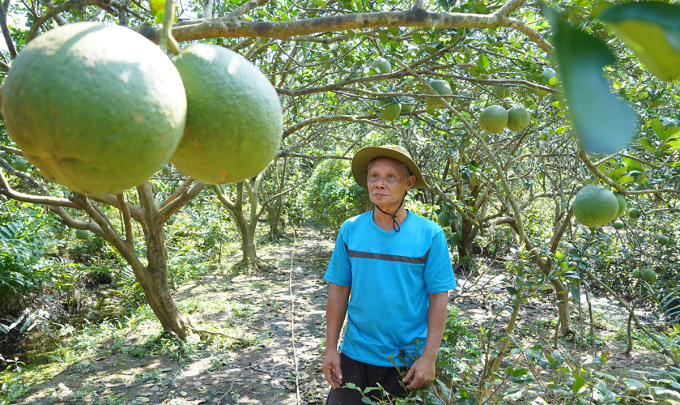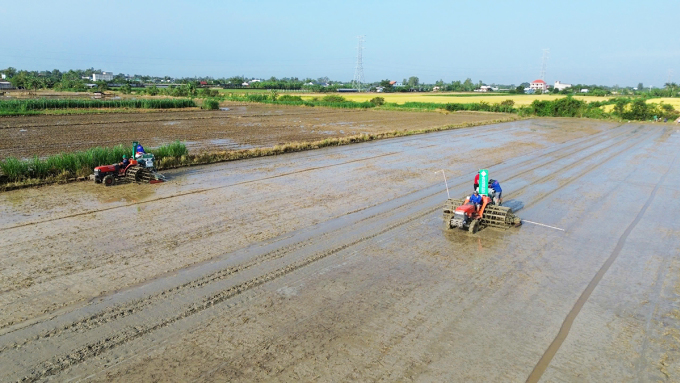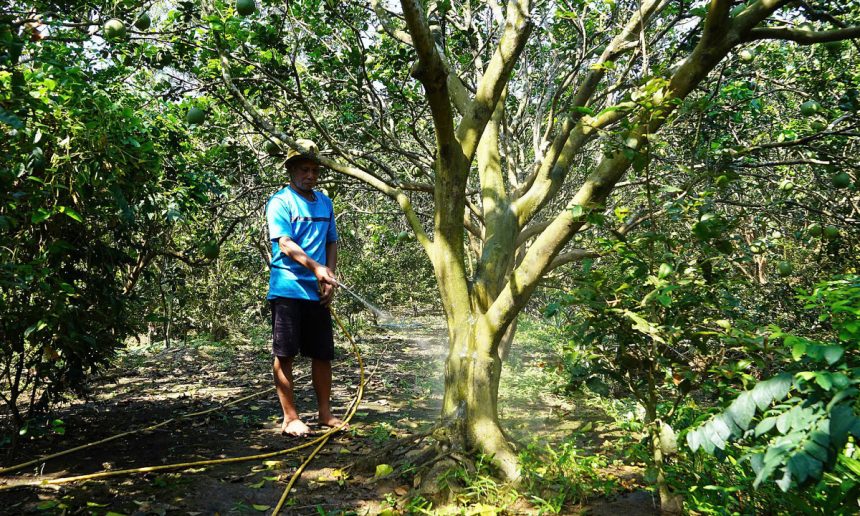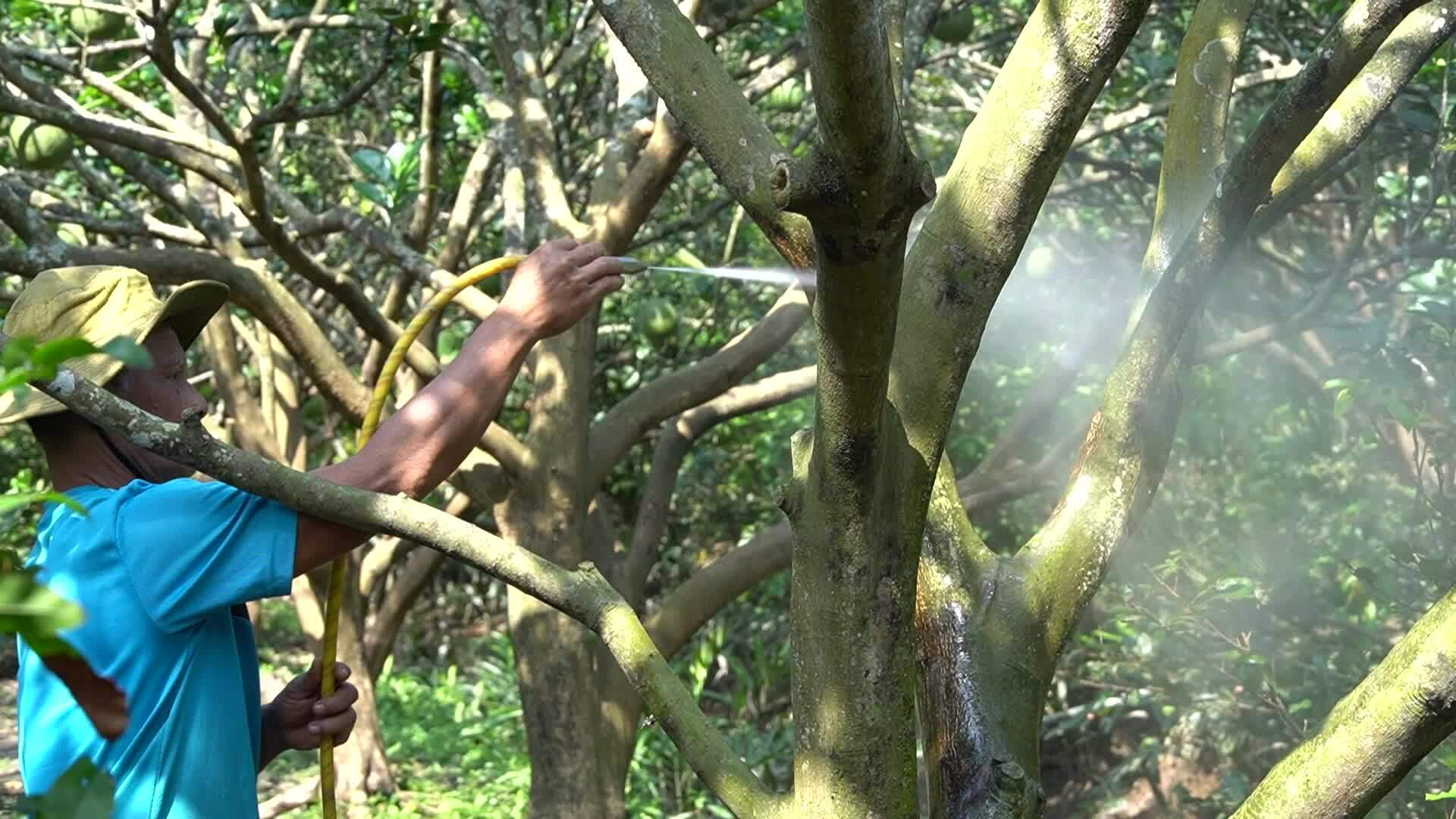Salinity came nearly a month early in Ben Tre and Tien Giang, affecting domestic water, threatening many areas of rice and fruit trees during the Tet harvest season.
At noon on December 30, Mr. Tran Long Son, 62 years old in Long Hoi hamlet (Giao Long, Chau Thanh, Ben Tre) used a high-pressure nozzle to clean the moss and fungi clinging to the grapefruit trunk. “The water in the ditch is shallow, tap water is more than 2 parts per thousand salty, but we have to use it because this year the salinity came early and there was no time to store fresh water,” Mr. Son said.

Mr. Tran Long Son is worried that the grapefruit garden will lose productivity and lose young fruit due to early and unusually high salinity. Image: Nam An
Mr. Son’s family’s grapefruit garden of more than 3,000 m2 has been open for 10 years. In previous years, during the Lunar New Year, the tree produced 5-6 tons of fruit. After deducting expenses, he earned a profit of 30-40 million VND. In recent years, many droughts and saltwater intrusions, especially in 2019-2020, have weakened trees in the garden and reduced productivity.
This year, the garden owner spent about 50 million VND fertilizing and spraying, but the trees grew poorly. Over the past week, the salinity on the Tien River has been unusual, the highest time was nearly 10 parts per thousand, the lowest was more than 2 parts per thousand, the garden owner could not bring water from the river into the ditch to water the plants.
According to Mr. Son, unlike coconut trees that can withstand long periods of drought, if the crop of grapefruits that are bearing fruit during the Tet season lacks water, their productivity will be reduced. It is estimated that this year’s Tet season, the entire grapefruit garden can only salvage a few hundred kilograms, which is considered a loss of capital. If this condition persists, the tree is at risk of dying.
Mr. Son uses salty tap water to wash the grapefruit garden. Video: Nam An
About 100 meters from Mr. Son’s house, Mr. Huynh Ngoc Quang, 54 years old, said his family has a cement pond that stores 2 cubic meters of rainwater for the drought season. However, over the past week, his family had to drain rainwater for cooking because the tap water was salty. “The house has a car but I don’t dare wash it. The metal furniture in the house also rusts very quickly when using salt water,” Mr. Quang said.
Mr. Nguyen Anh Quoc, Head of the District’s Department of Agriculture and Rural Development, informed that the locality has more than 15,500 hectares of fruit trees, mainly coconut trees of more than 8,500 hectares and grapefruit of 3,500 hectares, all with salinity prevention culvert systems to protect them. .
This year, in parts of Giao Long and Truong Da communes, unusually high salinity came nearly a month earlier than local forecasts, causing difficulties for gardeners. Currently, about 300 hectares of grapefruit in the two above-mentioned localities are at risk of being threatened. According to Mr. Quoc, salinity only increased for about a day and then decreased, but did not last long.
The authorities of the affected areas set up zalo groups from communes to hamlets to promptly notify people when the salinity in the river decreases so that people can proactively collect water to store for the long drought and salinity season ahead.
Saline conditions coming early also occur in some localities in Tien Giang. In the past half month, a salinity of 0.43 parts per thousand has appeared in the Xuan Hoa sewer area (Cho Gao), higher than the same period in 2015, 2022, 2023. A salinity of 0.6 parts per thousand also penetrated My Tho City. . Authorities say this year the saltwater intrusion will come about 25 days earlier than the same period last year.

Many Dong-Spring rice areas in Go Cong (Tien Giang) have been sown at risk of being affected if salinity occurs abnormally. Image: Nam An
Tien Giang Department of Agriculture and Rural Development said that from December 20 to 27, the Go Cong freshening area sowed nearly 1,700 hectares of winter-spring crop, with the remaining more than 800 hectares being harvested and then sown. If in February and March 2025, complicated salinity developments make it impossible to get fresh water to supply to this area, the above rice area is at risk of being affected.
Mr. Vo Van Thong, Director of Tien Giang Hydrometeorological Station, informed that from the end of December to February 2025, the total flow from the Mekong River to the Mekong Delta gradually decreased, at a level lower than the average for many years. from 10-20%. Two months later, the amount of water continuing to reach the delta was 5-15% lower than the average for many years.
In addition to this period, the Northeast monsoon operates continuously, so in December, some Western areas experienced two unusual saltwater intrusions. It is forecast that the saltwater intrusion situation in the dry season 2024-2025 will be higher than the average of many previous years, equivalent to and sometimes higher than the dry season 2023-2024.
During the dry spell that occurred earlier this year, saltwater intrusion in the West was not too severe, but it lasted a long time, greatly affecting people’s lives and production. Tens of thousands of households lack water, and many crop areas are dry. Localities such as Long An, Tien Giang and Ca Mau declared natural disaster emergencies and deployed response measures to prevent and overcome consequences.
Nam An




